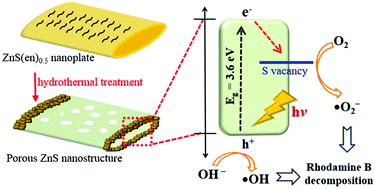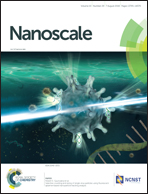Facile fabrication of porous ZnS nanostructures with a controlled amount of S vacancies for enhanced photocatalytic performances†
Abstract
ZnS nanostructures of barbell-shaped porous and hollow nanoplates with a controlled amount of S vacancies have been facilely fabricated via the hydrothermal treatment of ZnS(en)0.5 (en = ethylenediamine) nanoplates. The amount of S vacancies as well as the morphologies of ZnS nanostructures have been controlled by adjusting the hydrolysis time; the layered structure of ZnS(en)0.5 nanoplates decomposes to yield discrete ZnS nanoparticles at two end facets of template nanoplates, producing barbell-shaped porous and hollow ZnS nanoplates with abundant S vacancies finally. The photocatalytic activity of ZnS nanostructures prepared via hydrolysis for 4 h is 8.2 times higher than that of commercial ZnS. The photocatalytic activity of ZnS nanostructures increases with the increase of emission at 390 nm arising from sulfur vacancies, suggesting that the high photocatalytic efficiency of ZnS nanostructures results mainly from the high amount of sulfur vacancies. Surface defects such as sulfur vacancies can trap photogenerated electrons to block the recombination of charges, enhancing the photocatalytic efficiency of the as-prepared ZnS nanostructures. It has also been found that both ˙OH and ˙O2− act as the major reactive species in the photocatalytic decomposition of rhodamine B via our prepared ZnS nanostructures. Barbell-shaped porous and hollow ZnS nanoplates are suggested to have great applicability to photocatalysts in waste-water treatment.



 Please wait while we load your content...
Please wait while we load your content...